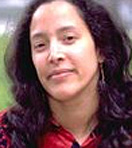News
‘Healthy Living’ program designed for Native-American youth
-
 Print
Print -
 Comments
Comments
-

“The combination of targeting this age group, these risk factors and a population that has particularly high behavioral risk factors makes for a solid overall wellness initiative with the potential to decrease cancer risk in the future.”
A School of Social Work researcher has developed and tested a “wellness curriculum” designed to improve the health of Native-American urban youth shown to be at higher risk of developing health problems, including cancer.
Hilary N. Weaver, professor of social work whose professional interests include multicultural social work and social welfare policy—in particular for Native Americans—tested her “Healthy Living in Two Worlds” wellness plan with 16 Native American youths between the ages of 9 and 13 staying at a summer camp.
The wellness curriculum, which targets the children’s diet, exercise habits and recreational tobacco use, earned the approval of parents of the children attending the summer camp. Now, Weaver’s team will study the possible benefits of the health program and develop a plan that can be used with other Native-American youth.
Native youth in Buffalo and Niagara Falls and their caregivers were interviewed for the study, funded by the National Cancer Institute, to find out more about their health behaviors and home environments, Weaver says. Prior to the study, this information had not been collected on urban Native-American youth in the Northeast.
This information then was used as a foundation for developing Weaver’s "Healthy Living in Two Worlds" curriculum.
“This program targets an urban population,” says Weaver, who grounded her program in the culture of the Haudenosaunee tribe prominent among Western New York Native Americans. “Native populations in cities are generally overlooked by programs and funding streams, even though the majority of native people have not lived on reservations for a long time now.
“The primary goal was to gather information on health behaviors, then use this information to shape a culturally grounded wellness intervention,” she says. “This is a first step in a larger process, rather than a project designed to produce generalized knowledge.
“The next step is to take what we have learned here, refine the curriculum and see if it can be developed as an effective template that can be adapted for use with different urban Native-American communities and different segments of native populations, including hard-to-reach youth.”
The project seeks to address three major risk factors for cancer: diet, use of tobacco and a sedentary lifestyle. All are behaviors people can change to decrease their risk of developing cancer, she says.
“Unfortunately, Native Americans are particularly high on all these risk factors,” notes Weaver, who is Native American. “We smoke more than other populations—and often at a younger age. We are now also considered to be the most obese population in the U.S., which says a lot about poor diet and being sedentary.”
Weaver says targeting this age group is “ideal” for instilling lifelong habits to increase healthy living.
“Young people these ages are faced with choices about smoking and are making more choices about what they eat,” she says. “This also is a good time for them to develop good habits around being physically active. The combination of targeting this age group, these risk factors and a population that has particularly high behavioral risk factors makes for a solid overall wellness initiative with the potential to decrease cancer risk in the future.”
The next step, Weaver says, is to run “Healthy Living” on a larger scale.
“With more youth involved,” she says, “it will be statistically possible to document the program’s effectiveness beyond the anecdotal reactions and feedback that we currently have.”
Weaver has submitted another proposal to the National Cancer Institute to further refine and test “Healthy Living in Two Worlds.” She expects a decision on further funding this month.
“The work here can be used as a model for other urban native populations to integrate local cultural traditions within a contemporary multicultural context,” she says.

Reader Comments